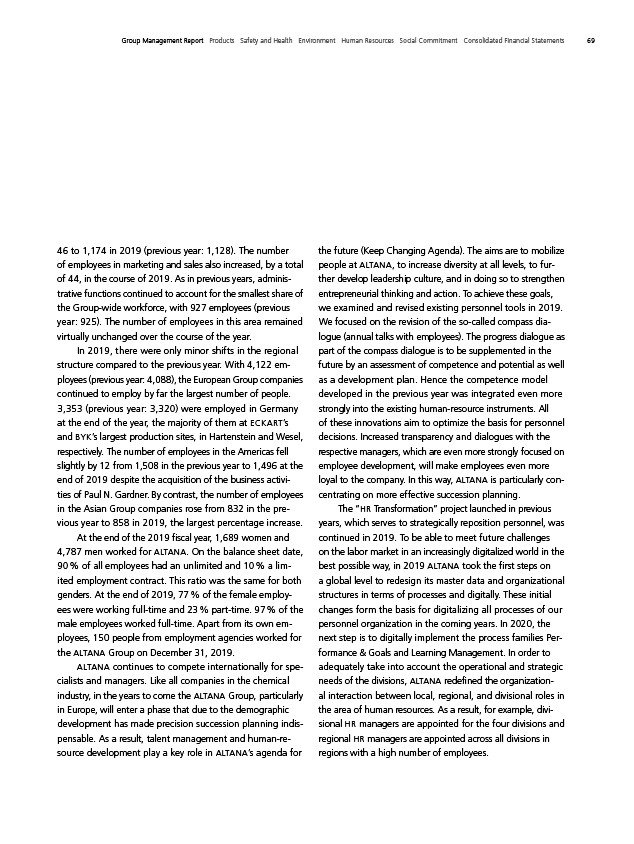
Group Management Report Products Safety and Health Environment Human Resources Social Commitment Consolidated Financial Statements 69
46 to 1,174 in 2019 (previous year: 1,128). The number
of employees in marketing and sales also increased, by a total
of 44, in the course of 2019. As in previous years, adminis-
trative functions continued to account for the smallest share of
the Group-wide workforce, with 927 employees (previous
year: 925). The number of employees in this area remained
virtually unchanged over the course of the year.
In 2019, there were only minor shifts in the regional
structure compared to the previous year. With 4,122 employees
(previous year: 4,088), the European Group companies
continued to employ by far the largest number of people.
3,353 (previous year: 3,320) were employed in Germany
at the end of the year, the majority of them at ECKART’s
and BYK’s largest production sites, in Hartenstein and Wesel,
respectively. The number of employees in the Americas fell
slightly by 12 from 1,508 in the previous year to 1,496 at the
end of 2019 despite the acquisition of the business activi-
ties of Paul N. Gardner. By contrast, the number of employees
in the Asian Group companies rose from 832 in the pre-
vious year to 858 in 2019, the largest percentage increase.
At the end of the 2019 fiscal year, 1,689 women and
4,787 men worked for ALTANA. On the balance sheet date,
90 % of all employees had an unlimited and 10 % a lim-
ited employment contract. This ratio was the same for both
genders. At the end of 2019, 77 % of the female employ-
ees were working full-time and 23 % part-time. 97 % of the
male employees worked full-time. Apart from its own employees,
150 people from employment agencies worked for
the ALTANA Group on December 31, 2019.
ALTANA continues to compete internationally for specialists
and managers. Like all companies in the chemical
industry, in the years to come the ALTANA Group, particularly
in Europe, will enter a phase that due to the demographic
development has made precision succession planning indispensable.
As a result, talent management and human-resource
development play a key role in ALTANA’s agenda for
the future (Keep Changing Agenda). The aims are to mobilize
people at ALTANA, to increase diversity at all levels, to further
develop leadership culture, and in doing so to strengthen
entrepreneurial thinking and action. To achieve these goals,
we examined and revised existing personnel tools in 2019.
We focused on the revision of the so-called compass dialogue
(annual talks with employees). The progress dialogue as
part of the compass dialogue is to be supplemented in the
future by an assessment of competence and potential as well
as a development plan. Hence the competence model
developed in the previous year was integrated even more
strongly into the existing human-resource instruments. All
of these innovations aim to optimize the basis for personnel
decisions. Increased transparency and dialogues with the
respective managers, which are even more strongly focused on
employee development, will make employees even more
loyal to the company. In this way, ALTANA is particularly concentrating
on more effective succession planning.
The “HR Transformation” project launched in previous
years, which serves to strategically reposition personnel, was
continued in 2019. To be able to meet future challenges
on the labor market in an increasingly digitalized world in the
best possible way, in 2019 ALTANA took the first steps on
a global level to redesign its master data and organizational
structures in terms of processes and digitally. These initial
changes form the basis for digitalizing all processes of our
personnel organization in the coming years. In 2020, the
next step is to digitally implement the process families Performance
& Goals and Learning Management. In order to
adequately take into account the operational and strategic
needs of the divisions, ALTANA redefined the organization-
al interaction between local, regional, and divisional roles in
the area of human resources. As a result, for example, divisional
HR managers are appointed for the four divisions and
regional HR managers are appointed across all divisions in
regions with a high number of employees.